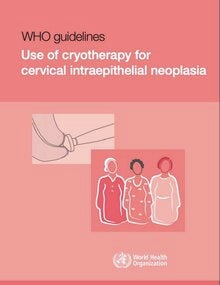Executive Summary
In 2008, cervical cancer was responsible for 275 000 deaths, of which about 88% occurred in low- and middle-income countries. In 2009, the World Health Organization (WHO) committed to updating the recommendations on the use of cryotherapy for cervical intraepithelial neoplasia (CIN), adhering to the WHO revision process of guideline development. This document summarizes the new evidencebased WHO recommendations about the use of cryotherapy in women with histologically confirmed CIN for low-, middle- and highincome countries.
The methods used to develop these guidelines follow the WHO handbook for guidelines development. An expert panel was established that included clinicians who provide cryotherapy services, researchers in cervical cancer prevention and treatment, programme directors and methodologists. An independentgroup of scientists at a WHO collaborating center conducted systematic reviews and produced evidence summaries following the GRADE (Grading of Recommendations, Assessment, Development and Evaluation) approach. GRADE evidence profiles were created for 16 key questions about the effects of cryotherapy in the presence of histologically confirmed CIN compared to no treatment and to loop electrosurgical excision procedure (LEEP), as well as the use of different techniques of cryotherapy. Conflict of interests were managed according to WHO rules.
The systematic reviews had very few randomized controlled trials or controlled observational studies, and therefore most of the recommendations are based on pooled results across observational studies in women receiving cryotherapy. Very few studies assessed outcomes that the expert panel had identified as critical to decision-making, including fertility and obstetrics outcomes, maternal morbidity, acceptability of the procedure to women or their health-care providers, referral rates for complications, and HIV acquisition and transmission. Thus, most of the resulting 14 recommendations are based on studies that included outcomes for recurrence rates of CIN, major and minor adverse events, and cervical cancer incidence and mortality rates.
|

